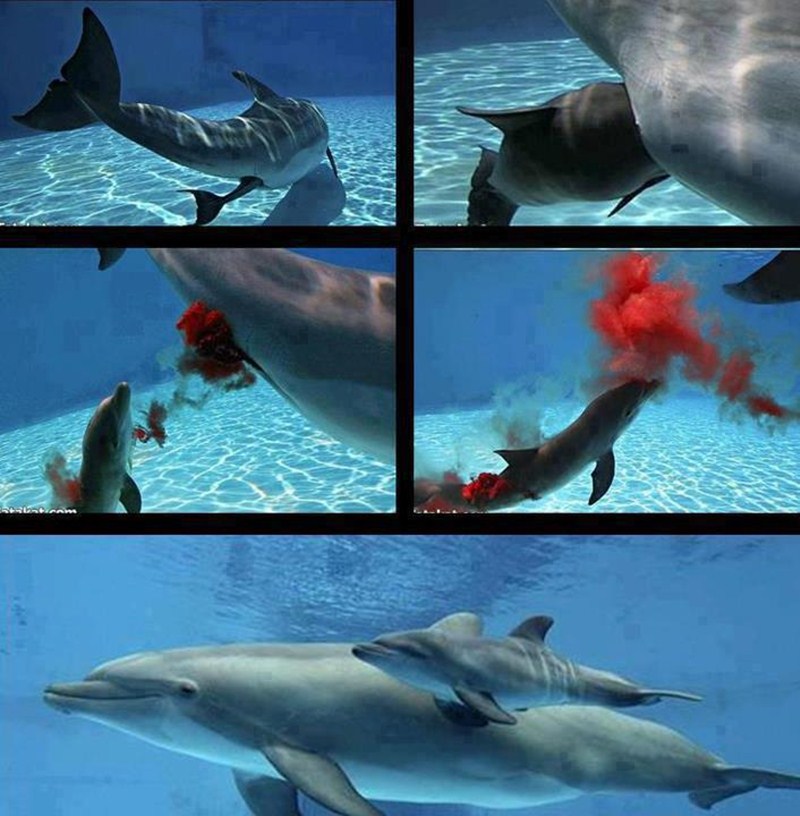Facts about Pregnancy and Birth of Dolphins
- Published by
- Posted on
- Leave your thoughts
-
The period of sexual maturity differs in both males and females and also the geographical location play an important role in sexual development. The maturity age for male dolphin is 10 to 15 years, whereas for females sexual maturity begins at an early age i.e. at 5 to 13 years.
Another interesting fact is that in most cases the sexual maturity determinant is the body size and not the age. When females gain 85 to 95% of adult body size they reach sexual maturity. Female do not have a constant ovulation cycle and they are believed to ovulate spontaneously for one to six times in a year. Usually the presence of a male dolphin stimulates ovulation. Unlike other monogamous mammals, dolphins breed with several partners during the breeding season.

Birth of Dolphin taking place in captivity
Male to male sex acts are also common in bottlenose dolphins, this activity is called “intromission” and male dolphins use it as a sign of bonding or recreation and in some cases they use it for showing aggression.
Male dolphins are very possessive about the female dolphins and two or more male dolphins are believed to “herd” female dolphins for mating purposes, this will keep them away from the access of other potential male dolphins. The uninterested female would prevent the male dolphin from mounting her by rolling away in an opposite direction. Female dolphins are often found helpful in making other female dolphins to escape from being herded.
There are numerous signs of impending birth observed in female dolphins such as irregular breathing, crunching or flexing up of the body, irritability, breaching, swimming rapidly upside down, decreased appetite and body temperature, vaginal discharge, contractions and lactation.
During the gestation period the fetus’s tail flukes and its dorsal fin remains folded inside the uterus of her mother, and remain soft till the time of birth. This allows the calf to come out quickly from its mother’s body at the time of birthing. The tail and dorsal fin stiffen within 2 weeks after birth.
Similar to the other mammals the dolphins carry one baby at a time and in some cases twins are born. The delivery process takes place while the female dolphin is swimming and the baby is born in “flukes first” position. The newly born calf weighs around 20 to 25 pounds and has a height of 2 to 3 feet.
Once the baby comes out of the uterus the mother quickly breaks the umbilical cord and helps the baby to swim to the surface to get the first breath of fresh air.
The bonding between the mother and the calf is so strong that even in the unfortunate cases of still births the mother dolphins have been found to take their dead calves to the water surface.
It takes some time for the newly born calf to get adjusted to the new environment. The baby dolphin breathes by “chin slapping” (raising the head higher than required on the surface of the water) to facilitate the breathing process.
Soon the calf learns to swim around his mother for both nursing and “slip streaming” i.e. the low pressure area created by the mother dolphin while swimming usually above or below and on sides. This enables the calf to save its energy from swimming and is used for rapid growth. Slip streaming also enables the calf to swim in controlled and upright manner.
The female dolphins nurse their babies for duration of 2 years and nursing takes place while swimming. The mother’s milk is very effective for baby’s growth and helps the baby gain ½ to ¾ of a pound every day for 6 months; it is compose of 40% fat. The colostrums present in the milk also save the baby from various infections. It takes 4 to 6 months for the calf to start feeding on solid food, where male calves accept solid food earlier than female ones.
The young calves stay with their mothers for 3 to 5 years and nurse for 2 years. Once the baby is mature enough to leave its mother it might again come in contact with her but cannot recognize familial relationship. There is also a possibility of breeding between close relatives but the chances are rare as the vast ocean reduces the probability of reunion.




